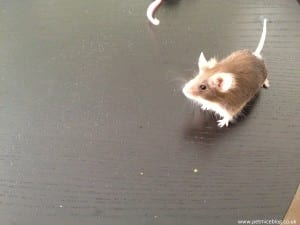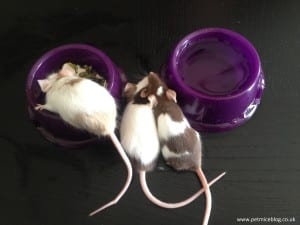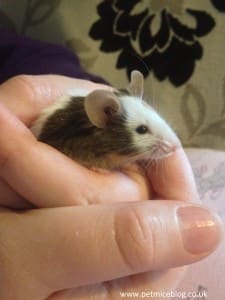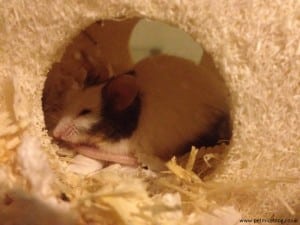Pet Mice Guide
Pet mice make great pets for children as well as adults. However, owning one or more of these little rodents comes with responsibilities much like any pet. Being well prepared and informed will make having pet mice a lot more enjoyable and easier.
This site is designed to provide a complete guide to help you choose and purchase your Pet Mice, buy all the necessary items you need, and help you care for them. As with most domestic animals that have been bred for some time, there is a wide range of types and colors to choose from.
A term for the domestic pet mouse bred for showing is ‘fancy mouse’, or in plural ‘fancy mice‘(click link to see the Wikipedia page on Fancy Mice). These are the mice that have been selected and bred more carefully. Often to carry on specific coloring or characteristic’s and are usually slightly larger than your typical pet mouse. There are different sections of this page you can jump to;
- Why people choose to own pet mice
- Preparing for your pet mice
- Choosing healthy pet mice
- Looking after your new pet mice
 Why people choose to own pet mice
Why people choose to own pet mice
Whether you are an experienced pet owner, or looking to have your first pet, taking in mice may well be for you. They are very active and inquisitive pets. Mice love digging and playing within their houses. They will take treats from you, sit in the palm of your hand and run up and down your arms.  You can form bonds over time, mice will become more familiar with their owners the more they are handled.
You can form bonds over time, mice will become more familiar with their owners the more they are handled.
Each mouse develops their own character and you will notice the difference in their personalities if you own more than one. Mice are low maintenance and easy to keep. Their living space should be cleaned out every week or so, putting in new bedding. Depending on the size of the food bowls and drinking bottle, fresh food and water once a day will usually do.
You will find some interesting facts in this post here. There will no doubt be somethings you didn’t know, and you may even be surprised by some! I have also put together some pros and cons to owning pet mice.
What is a Mouse?
A Mouse by definition is a small rodent, with a long thin tail. In the wild they rummage for food scraps and burrow fairly shallow into loose ground. There are several different types of mouse around the world and it is not uncommon to find them as pets. Historically mouse-like species are among the oldest known mammals on record.
Where to buy Mice?
There are two main options when looking to buy mice. The pet store, or the breeder. A pet store may be more convenient for you, but they will not be specialists in mice. There is always a risk that the mice you buy may not be the sex the store thought, or the exact age. Using a breeder you will generally get pets from someone who cares. They have bred these pets themselves and will likely know the exact age, the lineage and be aware of any health problems that might exist.
Breeds and Colors
Outside of the domestic pet mice that are readily available, there are several other types of species of mice. Here are some of the more well known that you may have heard of:
- House Mouse
- Field Mouse
- Wood Mouse
- Deer Mouse
- Harvest Mouse
- Dormouse
Obviously these other breeds are rarely kept as pets so we will not go into too much information regarding their differences to your common pet mouse.
You also have a wide variety of colors when it comes to pet mice. Not only pure colors but patchy, or mixed colors. So the options are almost limitless, here are some of the more popular colors that you are likely to find:
- Black
- Brown
- Grey
- White
- Albino (White with Red eyes)
- Yellow
- Creme
Preparing for your pet mice
Once you are sure you will be buying some fancy mice you need to be well prepared. Let’s face it, there is no point bringing them home and having nowhere for them to live, is there ?
Have a Home Ready for Your Mice
Before picking up your new pet(s) you will need a home for them. Although its normal to automatically assume mice need a cage, the type of cage with metal bars is not ideal. A house with a plastic top, plenty of air ventilation, some obstacles to have fun with and an exercise wheel is perfect. (see picture)
You need to use some common sense when deciding how many mice to house together. The house in the picture is adequate for 2-3 mice. Of course, make sure you have space available for their home. Away from direct sunlight, drafts, and any unpleasant conditions you wouldn’t like to live near.
There are plenty of options on the market. Two-tier cages are great for mice to exercise and explore. Glass tanks give you great visibility and hours of entertainment watching them play and dig. Or there are fun complex builds, and good all round affordable cages.
Have Plenty of Bedding
You will always need plenty of spare bedding to hand. No need to go super fancy, the product on the left will do just fine. If its designed for small rodents then it will be free from chemicals that might be harmful.
Try and put around a 3cm deep layer of bedding in the cage. Mice love to dig, burrow and play in thick bedding. They will often sleep, move items and make areas within the bedding. Shredded paper will also work as a welcome addition and give the mice something else to work with. Plenty of products are reviewed in the accessories section.
I have also put together some handy information on the different types of bedding available. Which are suitable for mice, and which are not. As well as some information on what mice are allergic to. Please read through this before deciding on the bedding you are going to be using.
Fresh Water and Food Supplies

Its also fun to buy or make some treats and give these to your mice on occasion. Passing them treats by hand will help build a better relationship between you and the mice.
I go into a lot more detail here regarding the food they will eat. You need to find a good balance of different foods that your individual pets enjoy, along with making sure they are getting enough nutritional goodness.
Fresh water on tap is the next necessity. You can either use a bowl or a water bottle. The problem I find with bowls, the mice usually manage to throw bits of food and bedding in with the water. The plus side to bottles are that they make less mess, but only one mice can use the bottle at one time.
If the cage you bought does not come equipped with a water bottle remember to make sure you can attach one before you buy. See water bottles and more reviewed in the accessories page.
Choosing healthy pet mice
When it comes to choosing your new pets I know how tempting it can be to pick the first cute mouse you see. However, you will benefit in the long run from taking some time to pick a healthy mouse that is ready to leave its litter/parents. Here are some questions you should be able to answer:,
How Old Is the Mouse?
You should not remove a baby mouse from its mother and litter mates before it is at least 6 weeks old. Removing them earlier than this can cause them distress and possible health problems due to being away from their mothers milk. Additionally, you increase the chance of the mouse being harder to socialize and develop all its natural skills.
What Is Their Gender?
Unless you want to wake up one morning and find litters of baby mice be sure not to mix males and females. In my experience males are easier to find as females are kept for breeding at shops.
Is the Mouse Healthy?
Make sure the prospective mouse has no visible damage, their tails, ears and legs should be clean with no marks on. Their fur/coats should be clean and shiny, showing they are comfortable and well groomed. Look and listen for signs of any laboured or noisy breathing. Viral disease spreads quickly among mice if present.
Looking after your new pet mice
 In general mice are not difficult pets to keep and enjoy. By now you should have the largest tank you were able to afford. There should be food, water, bedding, housing and any accessories you chose.
In general mice are not difficult pets to keep and enjoy. By now you should have the largest tank you were able to afford. There should be food, water, bedding, housing and any accessories you chose.
Introduce your mice to their new homes and watch them make it their own. They will move bedding around where they want it. Depending on their nature they may choose a location for themselves where they are comfortable. Or, they might huddle together and share body warmth.
Handling
Handling a pet mouse is a very important part of socializing and taming them. Generally speaking, the more you handle a mouse the more comfortable with human interaction they will be. As discussed earlier, each mouse has its own temperament, so different mice will take a different amount of time to become familiar with you, or other people looking to handle them.
Picking up a Mouse
There are a few points worth mentioning when it comes to picking up your little rodents. The most important thing here is that you never damage or hurt your mice. Remember, a mouse is a small animal, and often not motionless while being picked up so care is important.  You can pick up a mouse by the base of its tail briefly to help you get a grip of it.
You can pick up a mouse by the base of its tail briefly to help you get a grip of it.
Make sure you hold at the base of the tail to minimize pain, and do not hold it like this for long. To help with the process of taming mice, if you are sitting on the sofa and watching TV, place a mouse in a small box near you or on your lap. Then stroke or handle the mouse several times during the evening.
Once your mouse is comfortable with being handled when you approach it will not run away, and in time even approach you and run up your arm.
Health Problems
Mice are susceptible to a number of health problems. There are a number of things you can do to minimize the risk by taking good care of your pets. However, should any of you pets take a turn for the worst never hesitate to consult a vet that specializes in mice/rodent care. Some of the health issues owners come across and you’ll likely be able to recognize are as follows:
- Lice/Fleas
- Mousepox
- Respiratory problems
- Diarrhea
- Tumors
Fighting
Sometimes you will see fighting within a pack of mice. This is a lot more common when housing males together. I have experienced this first hand, where a mouse is aggressive towards other mice. He will bite their tails and into their backs causing a screeching noise and the panicked mouse to flee.
Unfortunately this situation rarely improves on its own, some mice are just not able to live peacefully with others. You have no other option but to separate the mouse that is being aggressive. It is better you do this sooner rather than later to restore harmony within your mice, and make sure do long lasting damage is done to the health of your mice.
Cleaning Out the Cage
 If you are providing a nice home for your mice to live in, the least you can do is keep it clean for them. Typically, depending on how many mice, and what size cage they have, you will need to clean them out once a week.
If you are providing a nice home for your mice to live in, the least you can do is keep it clean for them. Typically, depending on how many mice, and what size cage they have, you will need to clean them out once a week.
To do this, you will need to take out your mice and place them in a safe place. Somewhere they cannot escape or injure themselves. Then you will need to;
- Remove any toys or obstacles in the cage
- Tip out all the bedding
- Give the cage/tank a wipe with warm water and a little washing up liquid if needed
- Wipe the tank down with water to remove any chemical residue
- Put in all new bedding, about 3 cm deep will do
- Place all toys and obstacles back in, cleaned up if necessary
- Clean out food bowl and water bottle, replenish and place back in
- Place you mice back into their newly cleaned home and watch them enjoy
If you want something a little crazy check out mouse clothes.





Great article and lots of information! I recently bought two females and never realised how much fnu mice can be as pets.
Good to hear another satisfied owner of Mice, if you have any specific questions feel free to ask.
Hi! I am a wildlife rehabber, pet owner, lover of all creatures great and small. Recently, took in 3 baby white mice from a pet shop – they have lived in a very very large cage/box/enclosure originally designed for baby birds. It is about 4′ by 4′ with solid top, bottom, sides but a wire front. The mice are happy, and have given birth to 6 little mice.( I have 2 females and one male, so I presume he is mating with both females.) The cage was put in the fenced vegetable garden last week,where it is protected from rain by a tarp. They all seem very happy. My queries: can I open the cage and allow them to live in the garden? Obviously, I would continue to provide food, and in winter, dry hay etc. and would leave their cage available to them. There are field mice and voles that live there now, as I noticed one this morning inside the feed bag! I live bout 90 minutes north out of NYC. I am wondering if they would adapt and burrow, or if they would simply have no clue. Several of the domestic rabbits – all neutered – I rescued lived outside for years and burrowed in my yard. Might they survive, or is freedom a death sentence? Thanks. Paula
Hi Paula
Sounds like you’re doing an awesome job and looking after your mice really well.
As you got them from a pet shop I wouldn’t release them, their ability to survive on instinct will be reduced and their life expectancy will be reduced drastically. I don’t know the area without seeing it myself of course, I just don’t think they are prepared.
Hi Ive rescued a wild mouse. I believe it to be a harvest mouse but I will have a better look tomorrow. I live with my father and his cat always brings them in sometime alive and I will take them and put them in a glass take for the day and set them free in the field on the back of the house in the evening. The cat has brung one in today looks quite young but I didn’t get the best look as I grabbed it by the base of the tail and put it in a container and preparered a kritter keeper plastic cage for it with a bottle lid of water and some bird mix and some bedding. What I was wondering is about keeping it. I have young pet female mice in two big cages connecting. Do you know anything about hosing pet mice with a wild mouse? In the future once it Ajusts. I’m abit worried about it passing on parisites to my pet mice or the possibility of it being a male and the possiblity of them breeding I don’t want to breed again buT could they even breed the wild mouse is a male ? I think my dads cat goes into the field and finds the nests as before she had brung in tiny little dead ones this one seems a little bigger. It seems in shock but when I’ve gone near the tank I could Hear it nibbling on the seeds so that’s a good sign as i had one before that didn’t eat or move at all in the cage. So I set it free that evening as I thought it might be better for it.
Excellent article I learned something new about mice, thanks.
Great article! Thank you! I’ve just adopted 3 little girls and I’m working on taming them. They are loads of fun indeed! One can spend literally hours (night time!) on their “flying saucer” toy. I love watching them and I’d love them to become tame and not being afraid of me.
That’s great to hear, thanks for dropping by.
Hey Phil,
Thank you for the great tips!
We’ve had two little ones for a week now and we’re loving it. They are really amazing.
I have a quick question, if yoi don’t mind. They are not scared of us at all, they will take treats from our hands whenever we give them and we can put our hands in the cage no problem, they will either continue doing what they are doing or start sniffing us, however they seem a bit too curious in the sense that they bite quite a bit hahah. I only had one strong bite so far, they are usually very light bites and I’m not sure why they do it.
Everywhere i research they say mice can bite either because they are scared or because they smell food, but I know they are not scared at all, they come to us, sniff, start with light bites and then sometimes they get stronger as they go. We always wash our hands before we approach them (I’ve tried different handwashes to make sure it wasn’t the smell).
Is this something normal that they will stop doing with time or is that a way to train them to stop doing it?
Thank you again for the blog and the help.
Have a great day!
Hey Cora
Thanks for your comments.
It’s hard to say, I did have a mouse once that always bit me too actually but it’s very unusual, especially if they keep biting.
You’re doing everything right, I know it can help if you handle them less for a while, and also let them come to you rather than picking them up.
Although they don’t look stressed, they may be a little stressed by being picked up and prefer to find their own way onto, and off of your hands.
Hi Phil,
I acquired 2 young females 2 weeks ago. My vet thinks they’re 5-6 weeks old. One is already climbing into my hand and tries to climb my arm but I haven’t allowed it yet. I’m nervous she’ll escape. Any words of wisdom or counsel? Do I need to take a chance and trust her like she apparently trusts me?
Thanks!